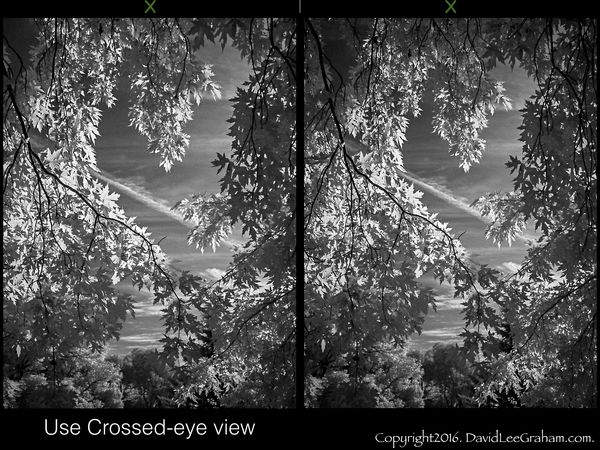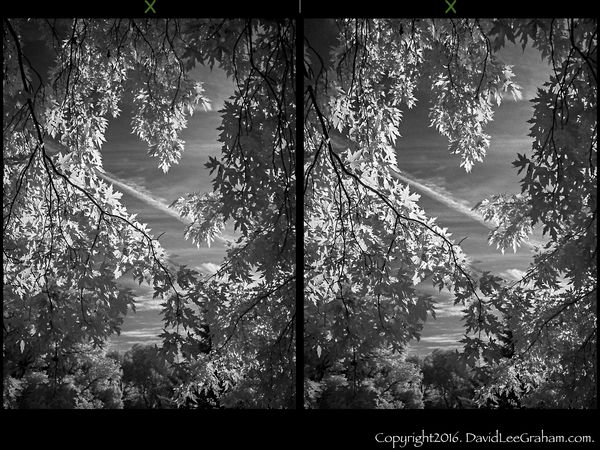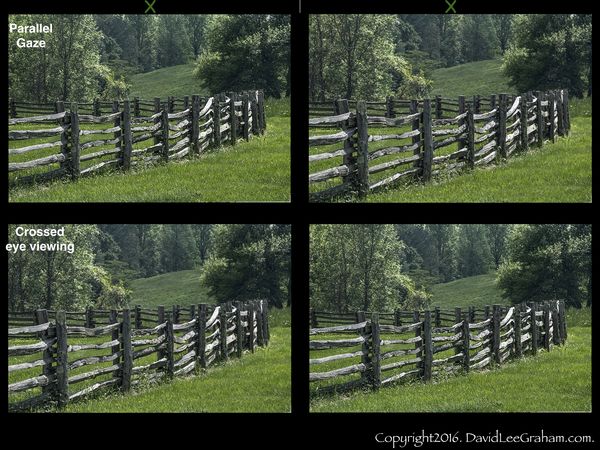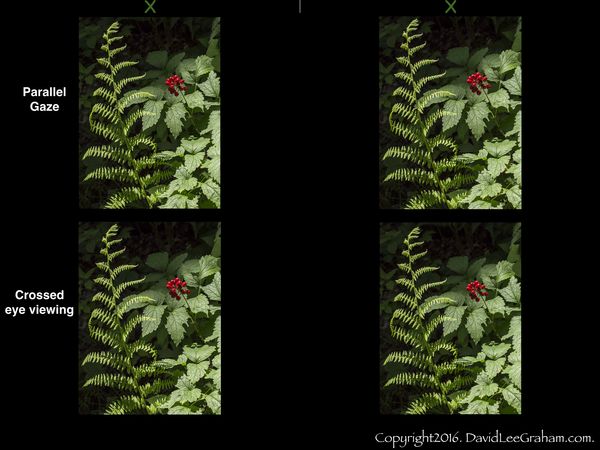Stereo (3-D) Photography
Jul 25, 2016 12:05:31 #
The purpose of this post is to discover if there are any photographers out there interested in and working with stereo photography. Some stereo pairs are produced with two different exposures made with the lens axes approximately "eye-distance" apart. Others are produced by modifying a copy of a single referent 2-D image in such a way as to enhance its internal cues to illusory depth perception that it can serve as the second member of a "stereo pair".
Any interest?
Any comments?
Any stereo images to offer?
Dave
xxxxxxxxxxxxxx
Quickie tutorial- Hand-held stereo pairs
http://www.uglyhedgehog.com/t-395113-1.html
A Hand-held Stereo Pair -A Succulent Garden
http://www.uglyhedgehog.com/t-396390-1.html
3-D effect with Stereoptical pairs from monoptical images
http://www.uglyhedgehog.com/t-397069-1.html
From Under the Canopy (IR, Stereoscopic pair)
http://www.uglyhedgehog.com/t-401770-1.html
xxxxxxxxxxxxx
Any interest?
Any comments?
Any stereo images to offer?
Dave
xxxxxxxxxxxxxx
Quickie tutorial- Hand-held stereo pairs
http://www.uglyhedgehog.com/t-395113-1.html
A Hand-held Stereo Pair -A Succulent Garden
http://www.uglyhedgehog.com/t-396390-1.html
3-D effect with Stereoptical pairs from monoptical images
http://www.uglyhedgehog.com/t-397069-1.html
From Under the Canopy (IR, Stereoscopic pair)
http://www.uglyhedgehog.com/t-401770-1.html
xxxxxxxxxxxxx
Jul 25, 2016 12:46:27 #
barbie.lewis
Loc: Livingston, Texas
Great post! I've been thinking about trying a bit of digital stereo photography lately.
We have a 1950's/60's Viewmaster stereo camera that we used to use. It produced four images in a standard 35-mm frame. Pairs of images were then cut apart (using a special cutting device that we have) and then mounted into the familiar Viewmaster reels for use with the viewers or with projectors (we have one) and polarized glasses.
We have a 1950's/60's Viewmaster stereo camera that we used to use. It produced four images in a standard 35-mm frame. Pairs of images were then cut apart (using a special cutting device that we have) and then mounted into the familiar Viewmaster reels for use with the viewers or with projectors (we have one) and polarized glasses.
Jul 25, 2016 14:13:52 #
barbie.lewis wrote:
Great post! I've been thinking about trying a bit of digital stereo photography lately.
We have a 1950's/60's Viewmaster stereo camera that we used to use. It produced four images in a standard 35-mm frame. Pairs of images were then cut apart (using a special cutting device that we have) and then mounted into the familiar Viewmaster reels for use with the viewers or with projectors (we have one) and polarized glasses.
We have a 1950's/60's Viewmaster stereo camera that we used to use. It produced four images in a standard 35-mm frame. Pairs of images were then cut apart (using a special cutting device that we have) and then mounted into the familiar Viewmaster reels for use with the viewers or with projectors (we have one) and polarized glasses.
Thank you, Barbie,
for looking and for your comments. I'm hoping that those on UHH that are working with digital stereoscopic imaging will join in the discussion.
Dave
Jul 25, 2016 18:46:25 #
I enjoy viewing using the cross-eyed technique!!
I have never tried to produce any.
Pat
I have never tried to produce any.
Pat
Jul 26, 2016 00:09:42 #
Hi, Pat,
Thanks for your comments.
I continue to be amazed at the ease with which some people us one style of stereo pair viewing, while finding the other style impossible. As one who sometimes finds crossed-eye viewing far more effective than parallel gaze....and at other times the opposite, I guess I should feel lucky at being able to use "whatever works" at any particular time.
If you can keep your camera reasonably level while hand-holding (the camera) it is really quite easy to take stereo pairs of images of stable scenes/subjects (architecture, statuary, landscapes).
Give it a try and let us see your images.
Best regards,
Dave
Thanks for your comments.
I continue to be amazed at the ease with which some people us one style of stereo pair viewing, while finding the other style impossible. As one who sometimes finds crossed-eye viewing far more effective than parallel gaze....and at other times the opposite, I guess I should feel lucky at being able to use "whatever works" at any particular time.
If you can keep your camera reasonably level while hand-holding (the camera) it is really quite easy to take stereo pairs of images of stable scenes/subjects (architecture, statuary, landscapes).
Give it a try and let us see your images.
Best regards,
Dave
Jul 26, 2016 10:09:09 #
I became re-interested in Stereo photog. after seeing the Fuji 3D W3 camera in person and joined our local Detroit Stereographic Society. The LCD viewfinder on this camera shows your shot in 3D without having to use glasses or cross your eyes, etc. I'd never heard of being able to see a 3D picture without having to wear glasses. How does it do it?
Jul 26, 2016 10:41:04 #
alliebess
Loc: suburban Philadelphia
Fotoartist wrote:
I became re-interested in Stereo photog. after seeing the Fuji 3D W3 camera in person and joined our local Detroit Stereographic Society. The LCD viewfinder on this camera shows your shot in 3D without having to use glasses or cross your eyes, etc. I'd never heard of being able to see a 3D picture without having to wear glasses. How does it do it?
Being able to see images in 3D without glasses is called free viewing, something I've never been able to do. I use an antique viewer to enjoy my collection of old stereo views.
Jul 26, 2016 11:51:31 #
No, I am not able to do free viewing either. This camera produces 3D images on its LCD screen that anyone can see in full 3D depth without glasses. Most amazing thing I've seen this year and I have a 3D TV, View master, Stereo cards, etc. etc. They are all nothing like this.
When I saw it, I got hooked on 3D again.
When I saw it, I got hooked on 3D again.
Jul 26, 2016 12:01:40 #
There was a guy on this forum a couple of years ago who did plenty of Stereo shots. I'm sure if you go to the search function at the top of the page you will find some information.
Jul 26, 2016 14:04:20 #
Fotoartist wrote:
No, I am not able to do free viewing either. This camera produces 3D images on its LCD screen that anyone can see in full 3D depth without glasses. Most amazing thing I've seen this year and I have a 3D TV, View master, Stereo cards, etc. etc. They are all nothing like this.
When I saw it, I got hooked on 3D again.
When I saw it, I got hooked on 3D again.
Hi, Fotoartist,
I've yet to meet a person unable to learn "free merging /free viewing" of stereo mages, whether or not they wear glasses.
The problem usually arise from trying to view images too large to view with the unaided eye. A very convenient method is to view the image pair in the display of a smartphone. Ideally, the images ought be centered approximately at approximately the viewer's inter pupillary distance, but it's not precise; 2 1/2" to 3 1/2 " generally work fine at a viewing distance somewhere between 8" to 19".
Here are a couple more mages that come across well on a cell phone, and they are provided for both styles of viewing.
for parallel gaze viewing relax the eyes by looking at infinity (at some out-door feature or even just across a large room...) and, with the images in the lower part ofypurfieldof vision, notice when there appear to be here, rather than just two images; then slowly adjust your view too the middle (illusory 3-D) image.
For crossed-eye viewing focus on a finger tip held close to your nose and over the space or line between the two images. Move the images closer or farther from your face until a third image appears understate focused finger tip...then gently concentrate on that focused middle image (3-D) as you move the finger from your view.
And please...let us know how you made out. Sometimes I can only make the crossed-eye technique work, sometimes only the parallel gaze technique.Take your time and try them both.
Good luck and best regards,
Dave
Jul 26, 2016 14:44:49 #
OK, I can do it. Now would you please answer my original question.
"...the Fuji 3D W3 digital camera...with LCD viewfinder...shows your shot in 3D on the LCD viewfinder without having to use glasses or cross your eyes, etc. I'd never heard of being able to see a 3D picture without having to wear glasses or look differently. So how does it do it?"
"...the Fuji 3D W3 digital camera...with LCD viewfinder...shows your shot in 3D on the LCD viewfinder without having to use glasses or cross your eyes, etc. I'd never heard of being able to see a 3D picture without having to wear glasses or look differently. So how does it do it?"
Jul 26, 2016 16:18:38 #
Fotoartist,
Glad to hear you can use free viewing. Should simplify thing in dealing with other stereo photographers.
As to how Fuji displays a 3-D image in its camera's display screen, I would explain it if I could!
After making the exposures in your Fujifilm FinePix Real 3D W3, how do you subsequently display and view them as 3-D images?
Dave
Glad to hear you can use free viewing. Should simplify thing in dealing with other stereo photographers.
As to how Fuji displays a 3-D image in its camera's display screen, I would explain it if I could!
After making the exposures in your Fujifilm FinePix Real 3D W3, how do you subsequently display and view them as 3-D images?
Dave
Jul 26, 2016 16:27:00 #
i too have been interested in 3d since my early years when i got my first sawyer viewmaster. now 70 years later, i've accummulated several hundred reels which my grand children love. my present 3d interest is in both still 3d and 3d videos. (i have a samsung 300m mirrorless camera along with the samsung 2d/3d lens which takes 3d images. and a sony hdr-td20 which takes both 2d and 3d high-definition videos). as for viewing these content, i have invested in two 3d lg hdtv's. both tv's are passive. one is 1080p and the other is 4k.
Jul 26, 2016 16:37:28 #
You get a digital file of course. Then you use a free program to convert it to an .mpo file and then it can be projected on a silver screen and viewed with the same 3D glasses you use at 3D movies. Or you can show it on your 3D TV.
Viewing it without glasses on the Fuji 3D camera is what intrigues me. Google the camera: Fuji 3D W3. You need to get into the 21st century.
Viewing it without glasses on the Fuji 3D camera is what intrigues me. Google the camera: Fuji 3D W3. You need to get into the 21st century.
Jul 26, 2016 18:13:04 #
Fotoartist wrote:
... You need to get into the 21st century.
You can find antique stereo viewers on eBay. These were very popular in the late 19th and early 20th century.
In the 1940's when 3D photography became popular for the masses with cameras like the Stereo Realist.
Stereo imaging had been around for a long time. What they all had in common was the simultaneous capture of two images through two lenses separated horizontally, just like your eyes are. Then by viewing each image through your two eyes using a viewer, which forced you to see the left image with your left eye and the right image with your right eye, your brain could easily perceive the 3D effect.
Another method was to project each image through a pair of Polaroid filters oriented 90 degrees from each other. You then you viewed the projected images through Polaroid lenses that were similarly aligned.
Also popular in the late 40s and early 50s were 3D comic books drawn using red and green ink that you viewed through red and green filters.
Another form of 3D image was captured from two positions at nearly the same time from a moving aircraft.
What all legitimate 3D photographic images have in common is that they are captured from two separate viewpoints using either two lenses or one lens and camera movement.
It is impossible to create a true 3D image from a single capture using only one lens.
If you want to reply, then register here. Registration is free and your account is created instantly, so you can post right away.









